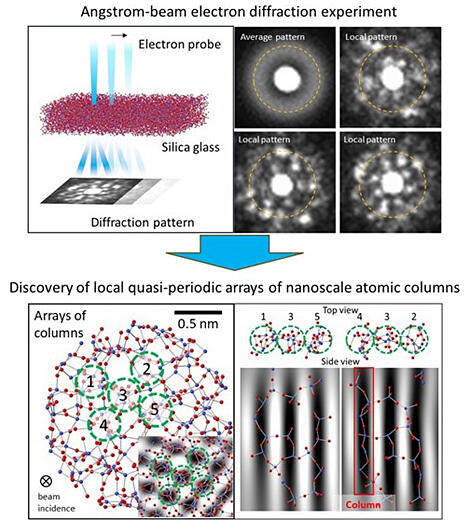A research group led by Professor Akihiko Hirata of the Graduate School of Fundamental Science and Engineering at Waseda University, Professor Motoki Shiga of the Unprecedented-scale Data Analytics Center at Tohoku University, and Group Leader Shinji Kohara of the Center for Basic Research on Materials at the National Institute for Materials Science (NIMS), announced that by employing angstrom beam electron diffraction, they discovered a local ordered structure in silica (SiO2) glass, the most common glass material with a seemingly irregular structure, in which nanoscale columnar structures are formed in nearly equally spaced rows. This ordered structure is closely related to density irregularities (density fluctuations) in glass and is expected to improve ionic conductivity, strength, and optical properties of glass materials to be used. The results are published in the international academic journal NPG Asia Materials on May 10.

Provided by Waseda University
Glass is an irregular solid material, and typical silica (SiO2) glass is known to have a characteristic distributed ring structure. When such glasses are exposed to short-wavelength waves such as X-rays or neutron beams, diffraction peaks called "FSDP" appear, which correspond especially to periods that are larger than the scale between atoms. The concept of the "quasilattice plane" was proposed regarding this phenomenon, which shows some degree of local regularity, but its details are not well understood.
In this study, they focused on the "first sharp diffraction peak (FSDP)" to clarify the details of the "quasilattice plane" in glass. Using the developed Angstrom electron diffraction method, they succeeded in directly observing very fine structures and discovered a nanoscale columnar structure (a linear structure of approximately 2-nm long formed by atoms bonded together) of atoms in glass and several different periodicities related to their arrangement. The almost periodic arrangement of these columnar structures results in the formation of a planar region with "quasilattice plane," and this shed light on the origin of the characteristic diffraction peaks.
The columnar structures were connected to each other by atoms that act as bridges and were characterized by nearly equally spaced alignment to form a quasilattice plane, which was inferred to give rise to FSDP. Moreover, columnar voids were formed around these columnar structures, suggesting the existence of distinct density fluctuations.
In the future, they aim to develop glass materials with even higher performance by systematically investigating the type of density fluctuations, especially structures that can be called defects, introduced by different types of glass and fabrication methods.
Hirata said, "By observing the local structure of silica glass with electron beams from a direction where its regularity is clearly visible, we were able to obtain more structural information than ever before. Together with computer analysis, we were able to clarify the characteristics of density fluctuations that have been discussed in the past. Analysis of such density fluctuations will be an indispensable technique for the development of glass materials in the future as it determines the properties of glass materials for various applications."
Journal Information
Publication: NPG Asia Materials
Title: Direct observation of the atomic density fluctuation originating from the first sharp diffraction peak in SiO2 glass
DOI: 10.1038/s41427-024-00544-w
This article has been translated by JST with permission from The Science News Ltd. (https://sci-news.co.jp/). Unauthorized reproduction of the article and photographs is prohibited.




